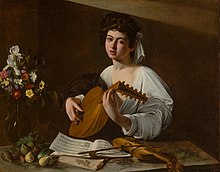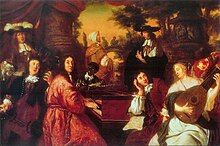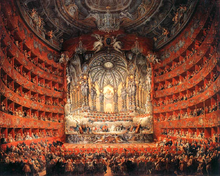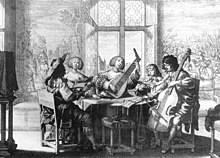Baroque music

Baroque music , also known as the thoroughbass age , is a period in occidental art music that follows on from the music of the Renaissance and extends from the beginning of the 17th to around the middle of the 18th century. Today it is part of early music .
The beginning of the musical baroque is marked by the introduction of the figured bass in Claudio Monteverdi's compositions . The use of the continuous bass characterizes baroque music as well as the music of the subsequent transition period, the rococo . A possible further subdivision, which can only be regarded as approximate, is:
- Early baroque (around 1600 to 1650), under Italian dominance;
- High Baroque (around 1650 to 1710), with significant French influences;
- Late baroque (around 1710 to 1750), with a tendency to combine regional styles.
Johann Sebastian Bach and Georg Friedrich Händel are often regarded as the perfecters of the musical baroque. The so-called sensitive style was established among the Bach sons and their circle as early as the 1730s , leading from the pre-classical period of the Mannheim School to the Viennese Classical period with Joseph Haydn and Wolfgang Amadeus Mozart .
characterization
Characteristics emerging at the beginning of the 17th century, which can be regarded as the beginning of a new musical age, are, besides the figured bass, the monody (solo voice or instrumental part with accompaniment) and the newly emerging genres of opera and later instrumental concerto and oratorio .
Composition techniques
shape

During the baroque period, instrumental music - previously strictly linked to singing - emancipated itself. This can be seen in the concertante principle , the moving cooperation and quasi-competition of voices (vocal as well as instrumental). This development was favored by innovations in the field of instrument making, by the printing of music and by the nobility and bourgeoisie who commissioned compositions. The result was the Concerto grosso , which describes the change between a solo group ( Concertino ) and orchestra ( Tutti , Ripieno ). Instead of the group of soloists, a single soloist appears in the solo concert. Other musical forms that developed in the Baroque era were, for example, the suite , fugue , sonata , cantata and oratorio .
Operas were very important in the 18th century. On the one hand they were used for courtly representation, on the other hand - especially in Venice, where there were numerous public opera companies - they were, as it were, a popular spectacle. In Italy it was customary to incorporate well-known arias into new operas. When they were re-performed, operas were often adapted to singers and parts were exchanged. This is how so-called pasticci came about . In France in particular, the instrumental interludes were used to put together suites that were widely used.
expression
The musical language and melody was based on a rich system of characters that corresponded to a musical rhetoric and were linked to " affects ", that is, tried to show human states of mind. The chromatically descending bass line ( passus duriusculus ), which was often used when a lament had to be composed, is just one of many possible examples .
Especially in the early baroque period, the Venetian multi-choir - making music while taking spatial distribution into account - was continued.
structure
The polyphony that was created in the Middle Ages and was perfected in the Renaissance , i.e. the sounding together of independently guided melody lines, was widely used in the Baroque era. This polyphonic structure was often composed in imitation , for example in fugues . The figured bass was usually added to the melody voices as harmonic support.
The entire concerto movement was the opening motif influenced melodically and rhythmically; The ritornelle of the tutti structured the overall process. A constant repetition of rhythmic and melodic small motifs (motor skills) led to a fixed order of stress and accent structure. Cadenzas served as characteristic final turns to the formal structure and delimitation of clear key areas (major and minor keys) .
Sound theory
Baroque music was shaped by the exploration of chromatics . Following the tendency of the Renaissance, the church modes previously used in composition practice and in music theory are reduced to the two key genders major and minor and the two scales that are still used today . The tempered tunings were later developed from the mean- tone tunings that emerged in the Renaissance in order to enable playing in many keys without extremely sharp-sounding intervals. Keys with several accidentals are increasingly being used, and - unlike in the High Renaissance - alterations are always notated by the composer.
Instruments
Many of the instruments still in use today were developed in the Baroque period. The baroque forms of these instruments differ considerably in sound from their descendants, however, as there was a different sound ideal in which instruments were supposed to be reminiscent of the human voice. String instruments ( baroque violin ), but also woodwind instruments generally sounded quieter, less radiant and stable, but softer and more modulatable in their timbre.
The great wealth of instruments of the Renaissance dwindled in the Baroque. Among the flutes, the recorder was able to assert itself as a solo instrument in the treble position for a long time before it was ousted by the transverse flute . The reed instruments of the Renaissance period disappeared completely. The much quieter oboe was developed from the pommer . Bassdulzian and Rankett , which were still used in the early Baroque, were later replaced by the bassoon developed from the Dulzian . The chalumeau prevailed on instruments with a simple reed (not to be confused with the renaissance shawm). With the brass instruments, the trombone and initially also the zinc were adopted. The latter was mainly used in church music until the middle of the century. Among the string instruments, liras, rebecs, fiddles and finally the viols disappeared and were replaced by the violin family. The harp, lute and guitar were adopted and further developed for the plucked instruments . The mandolin developed from the mandora appeared in Italy. Only the timpani was adopted from the percussion instruments of the Renaissance . On the other hand, there were some curious phenomena at this time, such as the Pantalonian cymbal in Saxony and the Salterio in Italy, which even achieved a certain widespread effect. In French baroque music in particular, older instruments such as the hurdy-gurdy or soft-sounding bagpipes were occasionally used.
The orchestra , built on string instruments and supplemented with wind instruments , including the famous Electoral Saxon and Royal Polish Chapels in Dresden and Warsaw , began to standardize - gradually turning away from the free and changing instrumental line-ups of the Renaissance. Keyboard instruments such as the harpsichord and organ were expanded in size and registers, and their mechanics improved.
Important representatives (selection)
| Sub-epoch | Beginning | end | In Italy | In Germany | rest of Europe |
|---|---|---|---|---|---|
| Early baroque | 1580-1600 | 1630-1650 | |||
| High baroque | 1630-1650 | 1680-1700 | |||
| Late baroque | 1680-1700 | 1730-1750 |
See also the list of baroque composers .
Early baroque
At the beginning of the Baroque was Claudio Monteverdi (1567–1643), who did pioneering work with compositional innovations and the further development of young musical genres. He was one of the first composers to combine the new developments emerging in the late Renaissance. Especially in the field of dissonance treatment, he was a downright pioneer. The Venetian Giovanni Gabrieli (approx. 1554 / 57–1612) was the first to realize the principle of the competition between different groups of instruments and established the modern orchestral setting.
The pioneer of the German baroque suite was Hans Leo Haßler (1564–1612), who was influenced by the Venetian school . Even Heinrich Schütz (1585-1672) took the new Italian style as a model and connected him with expressions of the German language, which earned him the first German composer European reputation. Like Schütz, the organ master Jan Pieterszoon Sweelinck (1562–1621) exerted a great influence, which was partly reflected in the works of her students.
As a result, new instrumental and vowel forms were significantly influenced by Girolamo Frescobaldi (1583–1643), Giacomo Carissimi (1605–1674) and Johann Heinrich Schmelzer (1623–1680), among others .
High baroque
The French musical life of the late 17th century was significantly influenced by Jean-Baptiste Lully (1632–1687) at the court of Louis XIV . The catchy music of Lully, which above all satisfied the dance enthusiasm of this epoch, shaped the “Baroque”; court life. As a typical French musical form is the suite called, often by a French overture was initiated. Ballet was also of great importance .
In contrast to Lully's popular, dance-oriented style, the more intellectual and perhaps “progressive” Italian music, the chief representative of which was Arcangelo Corelli (1653–1713), was in the foreground in the high baroque period .
In Germany, the music was mainly influenced by the composers of the North German organ school , whose most representative representative was Dietrich Buxtehude (1637–1707). The cantata was created here from the sacred concert .
In England, Henry Purcell (1659–1695) and others developed a style of their own.
Late baroque
While music developed independently in different regions of Europe in the high baroque period, the late baroque period was characterized by the cross-border spread of styles. Georg Philipp Telemann (1681–1767) drove this development forward in Germany and eventually became an “icon” among the musicians. Other famous German composers of the late Baroque were Carl Heinrich Graun and Johann Adolph Hasse . Nowadays, Johann Sebastian Bach (1685–1750) is considered by many to be the “finisher” of the late baroque. During his lifetime, however, he was far less famous than those mentioned above and valued more as an organ virtuoso than as a composer. Stylistically, a large part of his music follows the high baroque rather than the late baroque.
The Italian violinist and composer Antonio Vivaldi (1678–1741), who gained new popularity in the 20th century, influenced many other composers with his concert form. Operas were particularly popular in the late baroque period. In England, Georg Friedrich Handel (1685–1759) was particularly productive in this area. The Italian Domenico Scarlatti (1685–1757), composer of numerous one-movement harpsichord sonatas , was active on the Iberian Peninsula.
With the death of Telemann and other last representatives of German baroque music in the 1770s, the popularity of the sensitive and gallant style also waned in favor of Viennese classical music . However, there were composers in the baroque style until the end of the 18th century. B. the Dutch Pieter Hellendaal, who was very popular in England during his lifetime .
Spiritual background
Absolutism , which found its purest expression at the court of Louis XIV and whose cultural work was imitated throughout Europe, is typical of the Baroque period . The culture flourished under feudal support, and in buildings, gardens and other things, the representative and monumental to the exaggerated was sought.
The name of this epoch comes from the Portuguese "barroca" - an ambiguous term that includes a. Clay vessels, but also means clay / rubble. In contrast, "barocca" is the later Italian variant - here already exclusively as a designation of the baroque epoch. The term baroque is definitely a rather unfriendly title that only became the name of the epoch in the neighboring baroque period. Frisch's German = French dictionary (“other edition”, 1719) describes “baroque” as a pearl that is “not completely round”.
Otherwise, the contemporary of the Baroque felt like a representative of a modern, open-minded, "gallant" time. The fact that the stylistic term “baroque” stands for quite different trends of the time is problematic. The early baroque tended to be rough and rough - in complete contrast to the gallantry of the high baroque. The term “late baroque” is also problematic because it overlaps later epochs that actually have their own name ( Régence , Rococo ).
In the arts of the Baroque period, people were particularly interested in expressing the various human moods ( affects ) and representing them in fixed forms.
There was a particular preference for allegory , at that time also known as a "symbol" in German-speaking countries. The ideals of gallantry were actually meant in terms of moral philosophy . It was simply about regulating human coexistence: consideration, courtesy, politeness, tolerance. But even then, “easy-going” spirits reinterpreted the character of the gallant into a way of life that was concerned with taking the opposite sex for itself with pretended decency. Religious enthusiasts took this as an opportunity to generally assume sinful intentions to be avowedly gallant ladies and gentlemen. This is where the contradictions of the baroque become apparent: on the one hand, it stands for joie de vivre, lust - on the other hand, one repeatedly comes across strictly ascetic attitudes (see, among others, pietism ).
With the death of the Sun King (1715) the sense of time seemed to have changed. From around 1715 onwards, completely new trends emerged in fashion: the baroque was slowly being adopted and the Regence style was emerging - it was replaced by the rococo around the middle of the century, but the terms "baroque" and "rococo" are becoming blurred in the area of music history. .
Modern reception
Rediscovery
After the end of the baroque age, baroque music was considered out of date and no longer performed. Only Handel's music, especially the oratorios, were not forgotten and were also performed at the end of the 18th and beginning of the 19th centuries. At the same time, several music lovers began to get into older music. Examples include Raphael Georg Kiesewetter , Simon Molitor and Johann Nikolaus Forkel .
An important milestone in the rediscovery of Johann Sebastian Bach was the re-performance of the St. Matthew Passion by Felix Mendelssohn Bartholdy in 1829. Other composers had to wait until the 20th century for their discovery, such as Antonio Vivaldi , who was hardly known until the 1920s knew as The Four Seasons .
Today's view
With the rediscovery of Bach by Mendelssohn, the fame and esteem of JS Bach, which continues to this day, began. Today, many of his works are regarded as the epitome and, in some cases, the “perfection” of the Baroque. However, Bach was hardly known outside of Saxony and Thuringia during his lifetime . In the 20th century, compositions by other composers of the Baroque era became increasingly known. Nevertheless, it was above all the popular interest in Bach that helped baroque music to revive.
Hugo Riemann and Guido Adler avoided the epoch designation “baroque”, which was shaped by architecture and the fine arts, as well as the term “renaissance” and tried to make a purely historical typification. For Riemann, “baroque” music means “music of the thoroughbass age ”. In the “Handbuch der Musikgeschichte” published by Adler, the term “baroque style” is only used in a short chapter by Arnold Schering .
Today, in the 21st century, baroque music is essentially interpreted in what is known as historical performance practice . Nowadays, performers of baroque music are aware of this knowledge, even if one compromises in individual cases with regard to the means used or consciously decides otherwise. The baroque repertoire also opened up with the historical performance practice, which was initially ridiculed and only prevailed around the 1970s (with interpreters such as Nikolaus Harnoncourt , Gustav Leonhardt, etc.). Today, a similar number of records of early music - including in particular the baroque - as of classical music of subsequent epochs are sold worldwide.
List of important baroque composers (selection)
See also
- List of Baroque Composers (a more complete list)
- List of baroque performers
- Baroque orchestra
literature
- Isolde Ahlgrimm: On today's performance practice of baroque music , in: Organa austriaca, 2 (1979), pp. 1–36
- Ingeborg Allihn (ed.): Baroque music guide. Instrumental music 1550-1770 , Metzler, Stuttgart 2001, ISBN 3-476-00979-3
- Rolf Dammann: The concept of music in the German Baroque , Volk, Cologne 1967 (3rd edition Laaber 1995), ISBN 3-89007-015-9
- Robert Haas: The music of the baroque , VG Athenaion, Potsdam, 1979, ISBN 3-7997-0728-X
- Hans J. Moser: The sounding cornerstone. The fate of German baroque music in twelve stories , Essen publishing house, Essen, 1937
Individual evidence
- ↑ Christoph Schüren: Giovanni Gabrieli: Canzoni e Sonate (ed. 1615) , online
- ↑ Werner Keil : An overview of the history of music. UTB 2012, p. 17.
- ↑ G. Adler (Ed.): Handbuch der Musikgeschichte. (1930) Reprint dtv, vol. 2, p. 683 ff.






